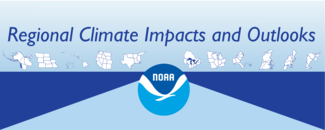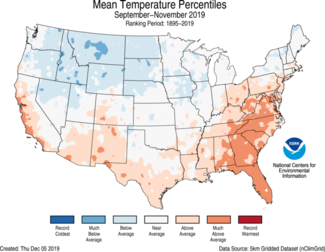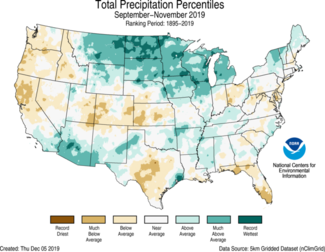
NOAA and its partners have released the latest Regional Climate Impacts and Outlooks, which recap fall conditions and provide insight into what to expect in the coming months.
Fall Temperature Recap
During meteorological fall (September–November), the average temperature for the Lower 48 was 53.87°F, 0.32°F above average, ranking in the middle third of the historical record.
Above- to much-above-average autumn temperatures spanned from the West Coast to the Southwest and from the Gulf Coast to the Mid-Atlantic region. Florida ranked fifth warmest while Georgia and South Carolina ranked sixth and seventh warmest, respectively.
Below-average temperatures for autumn were observed from the Northwest into northern Plains and also across parts of New England. Montana and Idaho ranked 17th and 18th coldest on record, respectively.
Three-Month Temperature Outlook
According to NOAA’s Climate Prediction Center (CPC), the February–April 2020 temperature outlook favors above-normal temperatures for central and southern portions of the West, the southern tier of the contiguous United States, and the East Coast. Increased chances for below-normal temperatures are forecast across the northern Great Plains, the Upper Mississippi Valley, and the western half of the Great Lakes.
Equal chances of above-, near-, or below-normal temperatures are indicated across the remainder of the contiguous United States. Above-normal temperatures are favored throughout much of Alaska, with the exception of the extreme southeastern mainland and the Southeast Panhandle region, which have equal chances of temperature ranges.
Fall Precipitation Recap
The fall precipitation total was 7.56 inches, 0.69 inch above average, ranking in the upper third of the historical record.
Above- to much-above-average precipitation was observed from the northern Plains to the Great Lakes and across parts of the Southwest, Northeast, and mid-Mississippi Valley to Ohio Valley. North Dakota, Minnesota, and Wisconsin each had its wettest autumn on record, with Michigan experiencing its second wettest such season on record. South Dakota, Iowa, and Arizona also ranked in the top ten wettest category.
Much-below- to below-average precipitation was observed across parts of the West, central Rockies, central to southern Plains, and Ohio to mid-Atlantic coast, as well as Florida, where the autumn precipitation ranked as the thirteenth driest on record.
Three-Month Precipitation Outlook
According to the CPC, the February–April 2020 precipitation outlook indicates enhanced probabilities of above-normal seasonal total precipitation amounts east-southeastward from the northern Intermountain region and northern Rockies across the northern Plains, most of the Mississippi Valley, the Great Lakes region, and the Ohio and Tennessee valleys.
Below-normal seasonal precipitation amounts are favored across southwestern Oregon, California, parts of West Texas, and much of Nevada, Arizona, and New Mexico. Equal chances are forecast among areas where seasonal precipitation amounts are expected to be similar to climatological probabilities. In Alaska, there are elevated probabilities of above-normal seasonal total precipitation amounts from about the Alaska Range northward to the Arctic Coast, and equal chances for approximately the southern third of the state.
Impacts and Outlooks for Your Region
Find more details for your region in the quarterly climate impacts and outlooks summaries:
- Alaska and Northwestern Canada Region
- Chesapeake Bay/Mid-Atlantic
- Great Lakes Region
- Gulf of Maine Region
- Midwest Region
- Missouri River Basin Region
- Northeast Region
- Pacific Region
- Southeast Region
- Southern Region
- Western Region
Creating These Quarterly Summaries
NOAA’s Regional Climate Services lead the production of these quarterly summaries of climate impacts and outlooks for various regions of the United States as well as parts of Canada along the border. This effort, which began in 2012, now includes as many as 11 unique regional products, all produced collaboratively with partner organizations.
You can access all of the Climate Impacts and Outlook summaries as well as additional reports and assessments through the U.S. Drought Portal Reports web page at Drought.gov.





